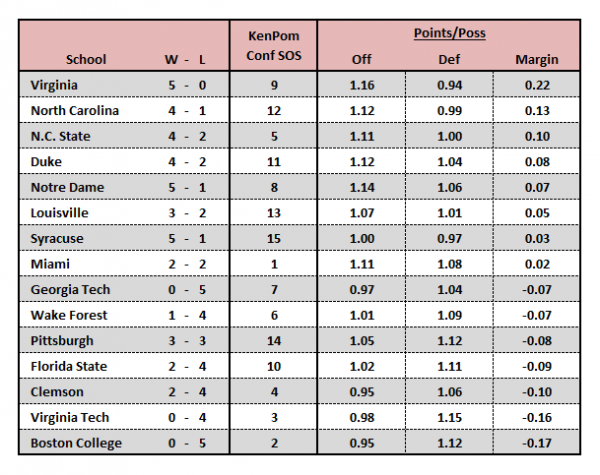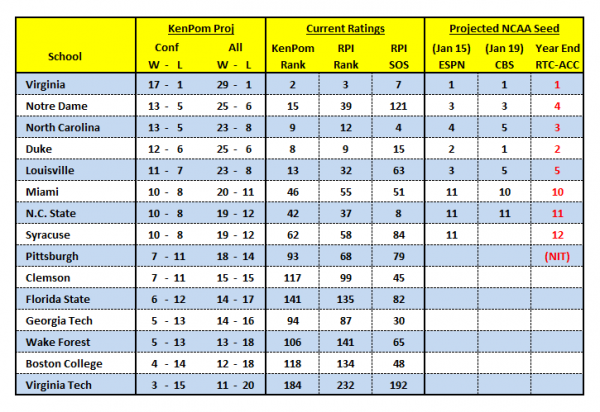Inside the ACC Numbers: Volume I
Posted by Brad Jenkins (@bradjenk) on January 22nd, 2015With approximately three weeks of conference play now in the books, it’s time to take a closer look at the ACC season. This is the first edition of a weekly look at the current ACC standings and team performances, focusing on which teams are playing better or worse than their records may indicate. We will also delve into some advanced metrics to find a few interesting team or player stats and trends. Finally, we will forecast how the final standings may look, and what that means for ACC schools’ postseason aspirations.
Note: All numbers are current for games played through Tuesday, January 20th.
Current Standings
It’s no revelation that Tony Bennett’s Virginia team has been the best team in the league to date, holding a larger points per possession (PPP) margin over second place North Carolina than the Tar Heels have over the sixth-best team, Louisville. And the Cavaliers are doing it at both ends of the floor, leading the league in offensive and defensive efficiency. It’s hard to understand why many of the experts only seem to talk about Virginia’s defense — which is great by the way — seemingly blinded by the fact the this is an equally outstanding offensive team as well. Not just “also pretty good,” but… “Outstanding!” Syracuse fans should probably be hesitant based on the discrepancy between the Orange’s gaudy 5-1 ACC record and their possession-based performance. Note that they have benefited from playing the least challenging conference schedule thus far, facing six teams that populate the bottom of the standings. Eventually the ACC heavyweights will show up on the docket, and that record is likely to backslide. Georgia Tech’s situation — dead last in the standings, but eighth in PPP — is what happens when the Jackets lose games by margins of one, three, five, seven and seven points. Pittsburgh may be in a similar spot as its former Big East rival from upstate New York, sporting a fortunate .500 record given their easy schedule.
Advanced Stat of the Week: North Carolina’s Rebounding (Both)
Whenever someone tells me that a team is a good or bad rebounding group, I always ask if they’re referring to offensive or defensive rebounding. Usually the response is one of bewilderment, but it gives me a chance to explain that not all rebounds are created equally. Rebound margin is a dinosaur measurement tool that has as much to do with which team misses more shots (the defense grabs more rebounds at a 2:1 ratio) than it reveals any prowess at grabbing those misses. But when someone tells me that North Carolina is a good rebounding team, I merely nod and agree. That’s because Roy Williams’ team leads the ACC in both offensive rebounding (44.6%) and defensive rebounding (74.2%) during conference play. In the last 10 ACC seasons, only Williams’ 2012 UNC squad achieved double-dominance on the glass, and seven other teams experienced years where they finished among the top two in offensive and defensive rebounding percentages. Six of those other teams were North Carolina, with only Wake Forest’s 2005 team joining that elite group. Interestingly, there was a weird situation back in 2004 that can’t have happened very often in a major conference. Clemson was the league leader in offensive rebounding percentage that yaer, but the Tigers had the worst offensive efficiency in the league. On the other hand, Wake Forest was the best defensive rebounding team, but — you guessed it — the Demon Deacons had the worst defensive team.
Future Forecast
The above chart gives us a predicted order of finish with final regular season records based on Ken Pomeroy’s current win probabilities for each team. As mentioned above, Syracuse and Pittsburgh project to slide down the ACC standings as their schedules get tougher, while Virginia appears headed for its second consecutive regular season title, perhaps even comfortably. We also include a few comparative rankings that are mentioned frequently when evaluating NCAA Tournament potential, as well as projections from two bracketology experts, ESPN‘s Joe Lunardi and CBS Sports‘ Jerry Palm. Note that while they project as if the field was named tomorrow, we make our projections based on final KenPom projected records. Here we give North Carolina credit for finishing tied for second in the league standings despite some early non-conference losses, and we knock Notre Dame down a bit for their horrible strength of schedule compared to the other top four teams in the league. We included N.C. State and Syracuse in the field of 68 for now, but that may be overly optimistic since they would each likely receive a 13th loss in the ACC Tournament. The Wolfpack went dancing last season with 13 losses, but keep in mind that selection was considered a big surprise to most experts.












































